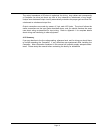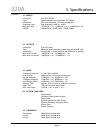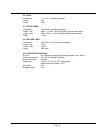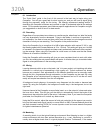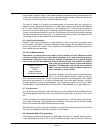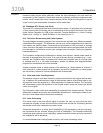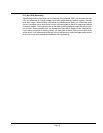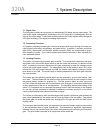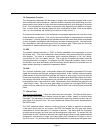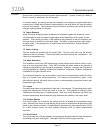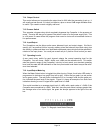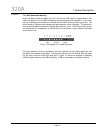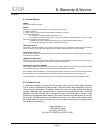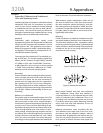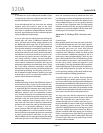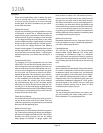
Page 21
7.4 Compressor Function
The compressor cooperates with the leveler to supply more consistent program level control
than possible with the leveler alone. While the leveler is relatively slow responding, the com-
pressor works much faster to control both the transients and other quick changes in the sound
level. The compressor has a variable compression ratio depending upon depth of compres-
sion. In other words, the ratio gets higher as more compression is used. Even at the highest
ratio it is not excessively stiff, achieving a maximum of only about 3:1.
The attack and release times of the compressor are program dependent as a function of the
audio waveform’s complexity. Thus, most of the sonic artifacts of compression are minimized
or eliminated. It can be generalized that transient sounds will cause faster attack and release
as well as greater compression than continuous and slow changing sounds. Like the leveler,
the compressor is also influenced by the DVG and silence gate. Either gate can force the
compressor to freeze and hold its gain control at a steady value.
7.5 DRC
The dynamic release computer, or “DRC” is directly imbedded in the compressor to control
the release time. This circuit detects the audio waveform and directly affects the compres-
sion detector. The result is a compressor which responds differently to “fat” and “dense”
sounds than for “thin” and “peaky” sounds. This is how the Compellor can better match the
changing elements in a program. For example, the DRC helps the Compellor match up a live
announcer’s voice level and density with the relatively heavier density of a recorded cut-in or
segue without resorting to excessive compression effects.
7.6 DVG
The “dynamic verification gate” continuously detects the Compellor’s processed VCA output
signal and computes the historical average of peak values. It also “verifies” when the present
peaks exceed or equal the historical average and outputs a “stop and go” control for both the
leveler and compressor functions. Whenever the present peak amplitude is below the histori-
cal average, the leveler and compressor gain controls are frozen by “gating” their respective
level detectors into a “stop and hold” mode. Otherwise the level detectors are gated into the
“ track and go” mode. Thus, the word “gate” does not indicate the audio signal itself is being
gated in any way, although our use of the term “Silence Gate” has confused some uninformed
users.
7.7 Silence Gate
This is not an audio gate. It does not affect the main audio path. The Silence Gate acts to
gate the gain control functions, thereby causing the gain to either “freeze” or continue being
controlled. The net effect is to prevent the background noise from swelling up when the pro-
gram stops for a period of time. You could interpret the Silence Gate as an augmentation to
the DVG function.
The DVG, described above, needs a continuing source of audio to maintain its operation.
If the audio should stop for any reason, the DVG first freezes the VCA gain then simply
relinquishes all control after about 1.5 seconds of silence. This would allow the Compellor
to begin recovering gain and thus bring up the background noise level. To prevent this, the
Silence Gate is used. Whenever the input audio signal drops below the user selected silence
threshold for one second or longer, the silence gate circuit freezes the VCA gain in lieu of
the DVG circuit. You should set the Silence Gate threshold to a level above the typical back-



